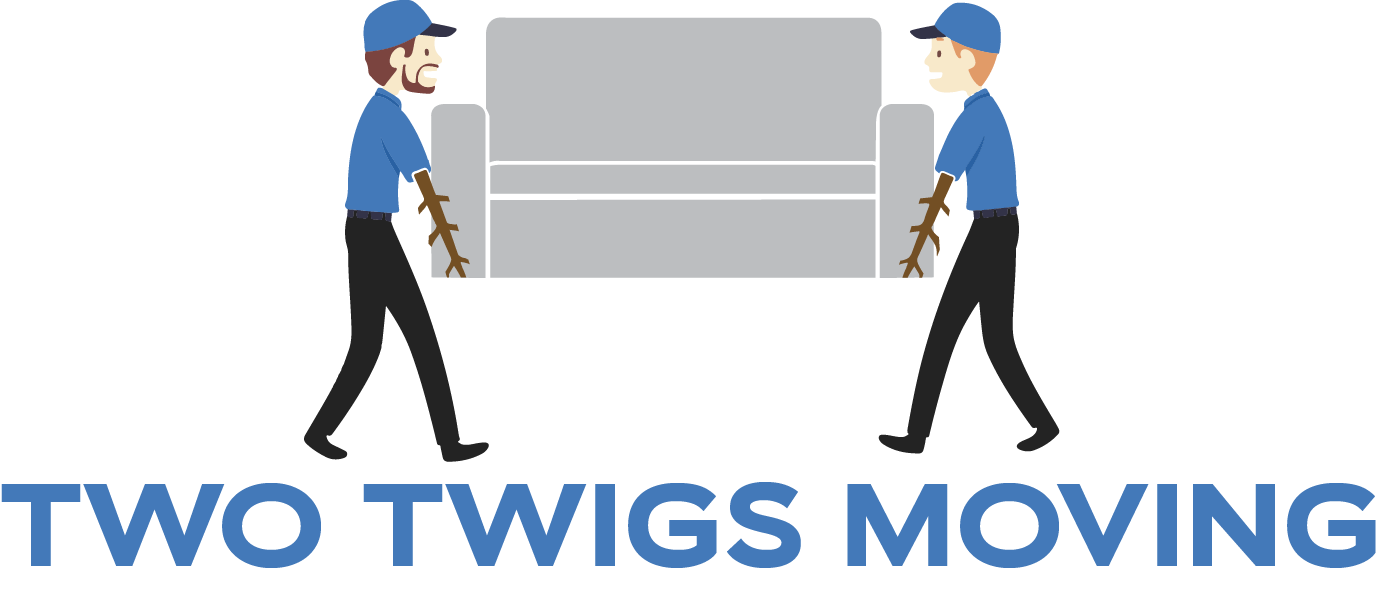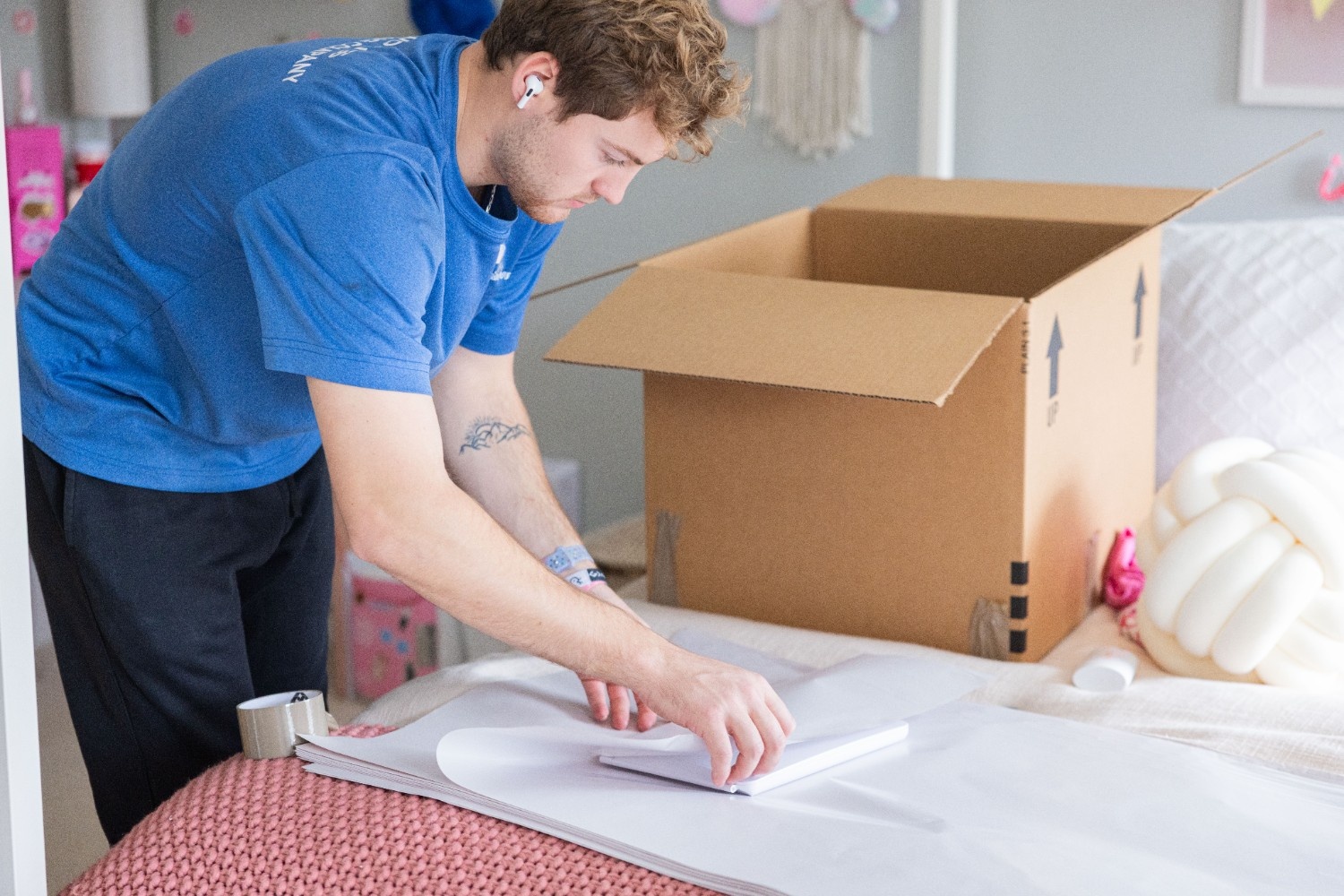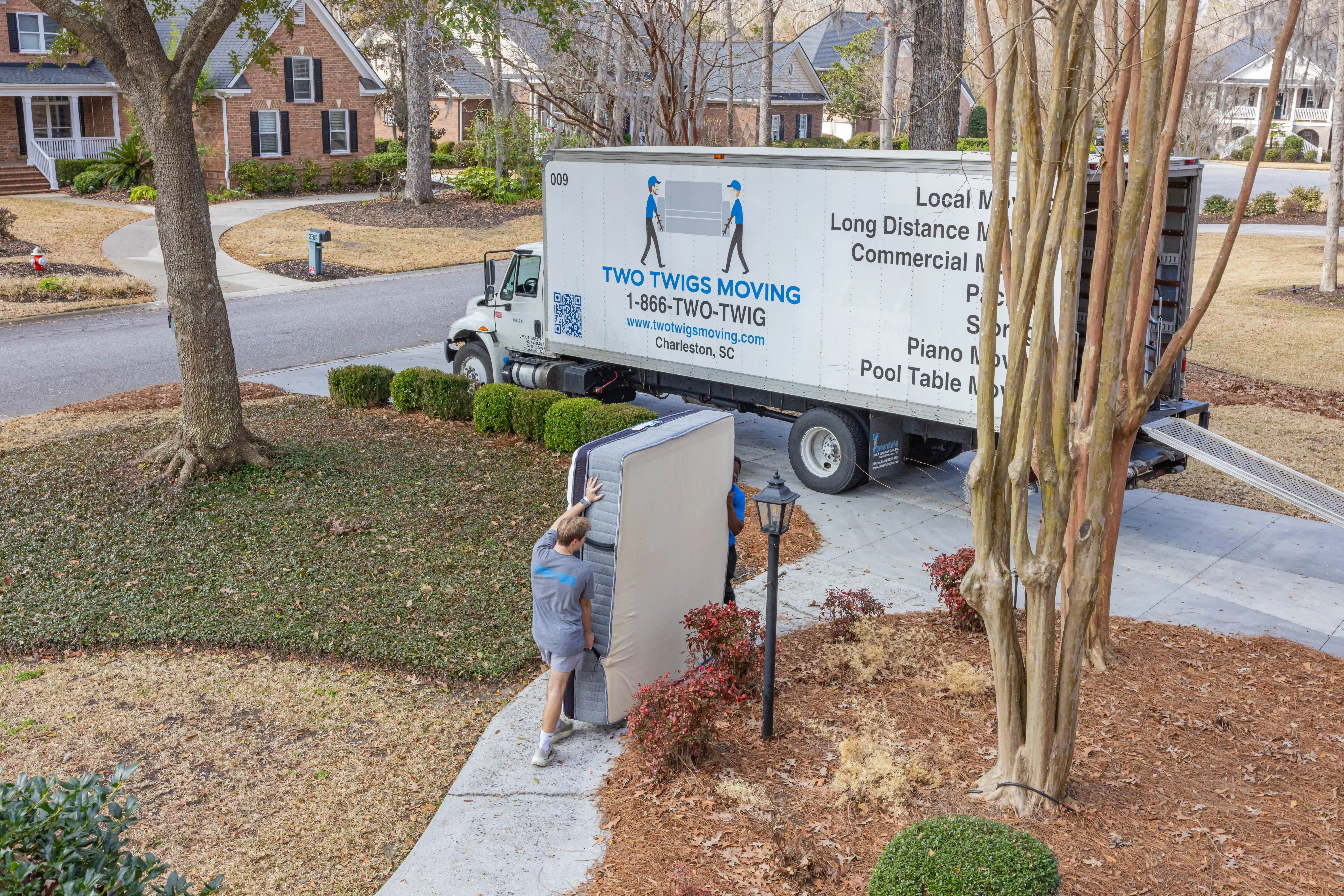Looking for the best moving boxes? Here’s a quick breakdown:
- Cardboard Boxes: Cost-effective ($1–$8 each), recyclable, and collapsible for easy storage. Great for short-term use but sensitive to moisture and pests.
- Plastic Bins: Durable, waterproof, and reusable. They cost more upfront ($10–$30 each or $1.50–$3.00 per week to rent) but offer superior protection and long-term value.
Quick Comparison:
| Feature | Cardboard Boxes | Plastic Bins |
|---|---|---|
| Cost | $1–$8 per box | $10–$30 per bin |
| Durability | Prone to damage | Sturdy, long-lasting |
| Weatherproof | Weakens when wet | Waterproof |
| Storage | Collapsible | Bulky when empty |
| Reuse | Limited | Reusable for years |
| Eco-Friendliness | Recyclable | Long-term use offsets impact |
Which is right for you? Use cardboard for budget-friendly, short-term moves. Opt for plastic bins for frequent moves or long-term storage. Your choice depends on your needs, budget, and priorities.
Cardboard Boxes: What You Need to Know
Cardboard boxes are a staple of the moving industry. Whether you’re planning a local move or heading across the country, understanding their features and limitations can make the process smoother.
What Cardboard Boxes Offer
Cardboard boxes come in a variety of sizes, from compact book boxes to large wardrobe boxes perfect for residential moves. Many are designed with specific purposes in mind, like dish packs for fragile kitchenware or wardrobe boxes for hanging clothes. Their versatility makes them a go-to choice for organizing and protecting belongings.
One of their standout features is that they can collapse flat, making storage simple when you’re not using them. This is especially helpful if you’re short on space or planning another move in the future. These practical qualities make cardboard boxes a convenient and budget-friendly option.
Benefits of Cardboard Boxes
Cardboard boxes are an affordable choice, typically costing $1–$8 per box. If you’re looking to save even more, you can often find free boxes at local stores, through online marketplaces, or from friends who recently moved.
Their corrugated design provides natural cushioning, absorbing shocks and vibrations during transit. This makes them a reliable option for protecting most household items during a move – provided they’re packed correctly.
Another plus? They’re environmentally friendly. About 88% of cardboard boxes are made from recycled materials. Once your move is done, you can recycle them again or pass them along to someone else who needs them.
Uniformity is another advantage. Professionally made moving boxes are typically the same size and shape, which makes stacking and labeling a breeze. This can save you time and effort during both packing and unpacking. However, despite these perks, cardboard boxes aren’t without their flaws.
Drawbacks of Cardboard Boxes
The biggest downside to cardboard boxes is their sensitivity to moisture. Rain, humidity, or even condensation can weaken the material, potentially causing the box to fail and damaging its contents.
"Cardboard is easily affected by moisture and humidity, leading to weakening, tearing, or mold formation."
– Elephant Trunk Moving Supplies
Cardboard boxes also have a limited lifespan. After a few uses, they may become too weak to safely hold your belongings, which can be frustrating for those who move frequently.
Another drawback is the assembly process. Each box needs to be folded and secured with packing tape, which adds time and requires additional supplies. This can make packing more tedious compared to pre-assembled options like plastic bins.
While cardboard boxes offer some protection, they aren’t the best choice for fragile items. To ensure safety, you’ll need to use extra padding materials like bubble wrap or packing paper, which adds to the overall cost and effort.
Finally, cardboard is vulnerable to pests. Insects and rodents can chew through the material, making these boxes less reliable for long-term storage. If you’re planning to store items for an extended period, you may want to consider sturdier alternatives.
Plastic Bins: What You Need to Know
Cardboard boxes are often chosen for their affordability and ability to collapse for storage, but plastic bins bring a different set of strengths to the table. They’re designed to provide durable, reliable protection – especially under challenging moving conditions. Whether you’re tackling a residential move or heading across state lines for a long-distance move, plastic bins offer weather resistance and extra security for your belongings.
What Plastic Bins Bring to the Table
Plastic bins are built tough. Their sturdy construction protects your items from impacts and pressure, making them a solid choice for handling the bumps and jolts of moving. Unlike cardboard, plastic bins are water-resistant, which makes them a lifesaver when moving in rainy weather or storing items in damp spaces. Plus, their smooth surfaces are easy to clean and sanitize, helping to keep germs and dirt at bay.
Another bonus? Plastic bins are stackable. Thanks to their interlocking design, they can be stacked up to 13 bins high without tipping or collapsing. This feature is particularly handy for apartment moves, where every square inch of space matters.
Now, let’s dive into the specific advantages that make plastic bins a strong choice for your next move.
Benefits of Plastic Bins
Plastic bins outshine cardboard boxes in several ways. They’re more durable and better equipped to handle tough conditions. Unlike cardboard, they won’t warp, crack, or splinter over time. They’re also resistant to water and chemicals, so they’ll keep your belongings safe no matter the environment.
Another plus? Plastic bins are ready to go as soon as you get them. There’s no need to fold, tape, or assemble anything – just pack and stack. Their reusability makes them a greener option, too. While they may cost more upfront, their long lifespan means you can use them for multiple moves, saving money in the long run.
"Plastic boxes can be re-used multiple times, reducing the overall environmental impact and making them a perfect sustainable choice. Lowering demand for single-use containers reduces waste and energy consumption."
But as great as plastic bins are, they’re not perfect. Let’s look at some of the challenges they present.
Drawbacks of Plastic Bins
One of the biggest downsides of plastic bins is the cost. A single bin can run you about $17 from suppliers like Uline, while cardboard boxes typically cost between $1 and $8. That’s a noticeable price difference.
Storage is another issue. Unlike collapsible cardboard boxes, plastic bins are bulky and take up a lot of room when not in use. They’re also heavier, which can make them harder to handle during a move.
Some moving experts even recommend sticking with cardboard for fragile items like glassware. Cardboard’s natural cushioning properties can provide better protection in certain cases.
Lastly, plastic bins don’t offer the same variety of shapes and sizes as cardboard boxes. Cardboard options like dish packs or wardrobe boxes are specifically designed for certain items, giving them an edge when it comes to packing flexibility.
Plastic bins definitely have their place, but it’s important to weigh their benefits against their limitations to decide if they’re the right fit for your move.
Cardboard Boxes vs Plastic Bins: Direct Comparison
Now that we’ve broken down the pros and cons of each option, let’s take a closer look at how they stack up side by side. The chart below highlights key features to help you weigh your choices.
Comparison Chart
| Feature | Cardboard Boxes | Plastic Bins |
|---|---|---|
| Initial Cost | Around $1–$8 per box | $10–$30 per box to buy or about $1.50–$3.00 per week to rent |
| Durability | Prone to crushing, tearing, and moisture damage | Sturdy and resistant to crushing, tearing, and moisture |
| Weather Protection | Weakens when wet, becoming soggy and fragile | Waterproof, shielding contents from rain or spills |
| Pest Resistance | Attracts pests that may chew through or nest inside | Keeps pests out effectively |
| Temperature Resistance | Limited protection against extreme temperatures | Handles extreme temperatures and fluctuations better |
| Reusability | Typically single-use, then recycled | Can be reused multiple times, reducing cost per move |
| Environmental Impact | Made from recyclable, biodegradable materials | Higher production footprint, but long-term use minimizes waste |
Cardboard boxes are the go-to for affordability and ease of recycling, but plastic bins stand out for their durability and long-term practicality. Jamie Shaner from Home Solutions of WNY, Inc. puts it best:
"Plastic totes keep out water, smoke, critters of any kind – it’s an issue that a lot of people deal with – and it’s a lot harder for those things to get into a box with a lid."
While plastic bins have a higher upfront and environmental cost due to production, their reusability spreads that impact over time, making them a more sustainable choice for repeated use. Whether you’re planning local moves or tackling long-distance relocations, this comparison can help you decide which option aligns with your needs.
sbb-itb-a5538b6
How to Choose the Right Moving Boxes
Picking between cardboard boxes and plastic bins isn’t a straightforward decision – it depends on factors like the type of items you’re moving, the distance, the weather, and your storage plans. Here’s a closer look at what to consider to make the best choice for your move.
What to Consider About Your Move
The items you’re packing play a big role in your decision. Fragile belongings like dishes, electronics, or heirlooms are better protected in plastic bins. Their rigid, waterproof design helps prevent crushing and moisture damage. Plastic bins also work well for heavier items, such as books, tools, or small appliances, as they won’t tear like cardboard might. On the other hand, cardboard boxes are a practical option for short, local moves where handling is minimal.
Plastic bins shine when you’re moving in unpredictable weather or storing items long-term. They handle rain, humidity, and temperature changes better than cardboard. However, cardboard boxes are easier to store when empty since they can be flattened, while plastic bins are durable and stackable, making them ideal for extended storage.
Budget and Reuse Options
Cost is another factor to weigh. Cardboard boxes range from $1 to $8 each, while plastic bins cost $10 to $30 apiece. Renting plastic bins is also an option, with prices starting at $1.50 to $3.00 per week . Although plastic bins require a higher upfront investment, they can be reused for multiple moves or storage, making them a more economical choice over time. Cardboard boxes, while cheaper and recyclable, are better suited for single-use scenarios. For frequent movers, plastic bins can help cut down on waste and provide better long-term value.
Professional Moving Help
If you’re unsure about the best option, professional movers can help you decide. For residential moves, which often involve a mix of household items and delicate possessions, experts can recommend the right balance of containers. Apartment moves and office relocations may benefit from the added durability and security of plastic bins. Local moving companies, such as Two Twigs Moving, can assess your needs and provide tailored advice. They also offer packing services to ensure your belongings are safely prepared for both local and long-distance moves.
Conclusion
When deciding between cardboard boxes and plastic bins, your choice should align with your specific moving needs. Cardboard boxes are a cost-effective option, especially for short-term, local moves. They’re easy to recycle once you’re done, making them a practical choice for budget-conscious movers. However, they may not withstand tough conditions or repeated use.
On the other hand, plastic bins stand out for their durability and reusability. While they come with a higher upfront cost, they can replace hundreds of cardboard boxes over time. They offer excellent protection against moisture, crushing, and weather-related damage, making them ideal for frequent movers or those needing long-term storage. In the long run, plastic bins can often save you money despite their initial expense.
The nature of your move can help guide your decision. For example, office relocations often benefit from the sturdiness of plastic bins to protect sensitive equipment and documents. Meanwhile, residential moves might suit either option, depending on your budget and the fragility of your items. For delicate or valuable belongings, plastic bins provide superior water resistance and protection against crushing.
Environmental considerations also play a role. While cardboard is recyclable, 55% of it globally comes from cutting down trees. Plastic bins, though less recyclable, can help offset environmental costs if used long-term due to their reusability.
Whether you’re planning a local move or a long-distance relocation, choosing the right container can make your move smoother and more efficient. Take the time to assess your specific needs, and consider reaching out to professional movers for tailored advice that fits your situation.
FAQs
When should you use cardboard boxes vs. plastic bins for moving?
Cardboard boxes are a smart pick for short-term moves. They’re budget-friendly, lightweight, and easy to stack, making them perfect for packing items that don’t need heavy-duty protection. Plus, they’re an eco-conscious choice since they can be recycled after you’re done with them.
On the flip side, plastic bins shine when durability and moisture resistance are priorities. They’re a go-to for long-term storage, damp spaces, or when moving in rainy weather. These bins safeguard your belongings from water damage and can be reused for future projects or storage needs.
Ultimately, the right choice comes down to your situation. In many cases, using a mix of both cardboard boxes and plastic bins can give you the best of both worlds – flexibility and reliable protection.
What’s the best way to pack fragile items safely in cardboard boxes?
When packing fragile items in cardboard boxes, it’s essential to prioritize protection. Start by choosing sturdy, double-walled boxes to provide added strength. Wrap each item separately using materials like bubble wrap, foam, or packing paper to create a protective layer. To keep things from moving around during transit, fill any gaps in the box with crumpled paper or packing peanuts.
Don’t forget to clearly label the box with "Fragile" and mark the correct side that should stay facing up. This simple step helps ensure movers handle the box carefully, minimizing the chances of damage. By following these precautions, your delicate items are more likely to arrive in one piece.
What are the environmental benefits of using plastic bins instead of cardboard boxes for moving?
Plastic bins come with several long-term benefits when it comes to reducing waste and conserving resources. These bins are sturdy, water-resistant, and reusable, making them a practical alternative to cardboard boxes. Unlike cardboard, which often wears out after a move or two, plastic bins can handle repeated use, whether for moving or storage. This durability means fewer replacements and less waste in the long run.
Cardboard boxes, while biodegradable and recyclable, don’t offer the same strength. They often need extra materials like tape for reinforcement, which adds to the waste. Opting for reusable plastic bins can streamline the moving process and cut down on single-use materials, making it a smarter choice for those looking to reduce their environmental footprint.


.svg)


